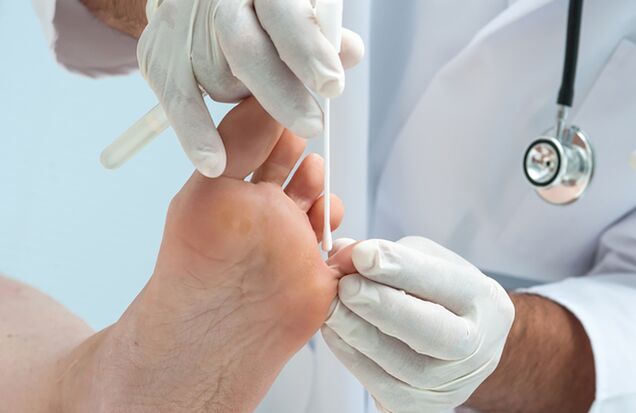
Treatment of fungal diseases should take place under the supervision of a dermatologist.Improperly selected antifungal agents can only lead to temporary improvement without healing the disease itself.
Treatment of fungal diseases should be necessarily subjected to the monitoring of the dermatologist.In case of self-determination, improperly selected antifungal agents can only lead to temporary improvement without healing the disease itself.
When choosing the therapy mode, it is necessary to take into account the area and form of damage, the degree of prevalence of fungi, the presence of simultaneous diseases, patient's age.
Antifungal medications are divided into two types: for external and internal use.The external agents themselves are efficient only in the early stages of the disease, then the treatment should be complex: the mushroom must be acted from outside and inside.
Internal medications
For successful and safe treatment of fungal diseases, it is recommended to adhere to certain rules with internal antifungal medications:
- The diagnosis must confirm the doctor.
- For the period of treatment of internal antifungal medications, it is recommended to limit the use of other medicines, with the exception of vital importance.
- Medicines should be used under the supervision of the doctor for a long time, as long as the fungus does not completely disappear.
- Control examinations must be performed at the beginning once every two weeks and then 1 time per month.Control scraping - 6 months after completion of treatment.When you discover the fungus, the reaction is necessary.
Currently, dermatologists consider pulse therapy the most efficient and safer treatment method - taking a long intervention medication.In some cases, the prescribed 1-week course of therapy, followed by a break of 3 weeks and then a new seven-day course of treatment.During entries, drugs accumulate in the body, and in the coming weeks continues to actively fight the infection.
The full flow of therapy is usually designed in three months.However, after its completion, the drug continues to operate during the year, protects the fungus from re-providing.This technique, on the one hand, enables the body to "relax" from the introduction of drugs, on the other hand, does not exclude the possibility of taking other drugs, including antibiotics.In addition, the risk of relapse is significantly reduced.
Outdoor drugs
With nail impairment, only internal medications are not used, but also in local medications - nail polishes and keratolytic patches and fats to remove keratine leather areas.
Those who can penetrate the nail and nail are used as antifungal varnishes as antifungal varnishes.Lake is applied to the top ribbons on top (the affected nail area area can be removed using the nail files attached to the Lacquer), clean and low -fat (for example, using alcohol) nails.
In addition, keratolytic fat and mortars can be used to remove the affected nail area.These products soften the nails, as a result, is easily and painlessly removed from the nail bed surface.Pattern is currently used as a keratolytic component or salicylic acid.Sometimes the patch composes an antiseptic or local antifungal agent.
Keratolytic patch is applied to the surface of the nail and closed with waterproof and curve.After 2-3 days, the affected areas were cleaned and the patch was glued again.Procedures are performed daily while the affected nails are not removed.The average duration of treatment is 6 months for nails on their hands and 9-12 months for nails on their feet.
In addition, special nail treatment sets are produced, which usually includes a fat that has an antifungal and keratolytic effect, nail scraper and patch.
Domestic creams are used for fungal skin lesions.The cream is applied daily to affected areas.The average treatment duration is 2-3 weeks;In the treatment of the foot - up to 6 weeks.
Processing infected things (disinfection)
In the process and after a fungal infection treatment, it is very important to disinfect everything that the fungus came into contact.Disinfection should be subjected to floors, walls, census, shower, bathrooms, as well as patients' personal belongings: underwear, shoes, leather and nail care items.
The walls and bottom of the bath should be treated with a mixture diluted consistency of the equal parts of the washing and chlorine powder or chlorine (powder must be washed after 30 minutes).You can also use a 5% solution of chlorine or chlorine lip or 3% Lysol solutions.
Shoes are recommended to be treated with formal solutions (25%) or acetic acid (40%).It should be thoroughly deleted by moistened installation of tampons and side parts of shoes.Then put the swab into the foot finger shoes and put only shoes in an airtight tied type of cellophane for 24 hours.After using acetic acid or 25% of formaline solutions, the shoes are aired or deleted ammonia to destroy the smell.
Underwear, stockings, socks, leggings can be disinfected in 15-20 minutes boiling in 2% SOAP ponds.Then they should iron them with hot iron.
Manicure scissors are disinfected, immerseed in alcohol, then worse over the burner flames.
Prevention
To prevent fungi infection, the following rules are recommended to follow the following rules:
- Use only your shoes.
- Do not wear cramped shoes in which a wet environment is preserved and the skin and nails are subjected to friction and microtrows.
- Shoe care, shoes after wearing should be well dried.
- It is recommended to use local antifungal means (fats, creams, varnishes) to people who often visit saunas, swimming pools, baths, sports and gyms.
- Refuse porous ballasts in the bathroom - they are poorly washed and therefore serve as a great refuge for different microorganisms, including fungi.















